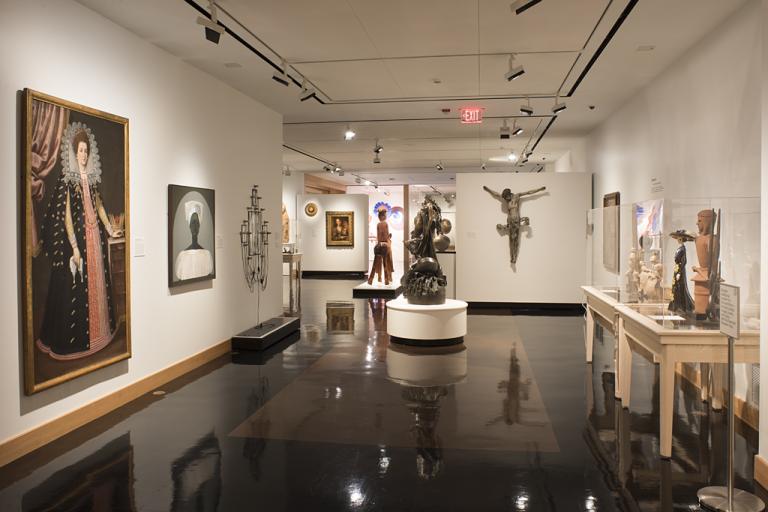untitled (scenes of life), Clementine Hunter
Artwork Overview

Canvas/Support (Height x Width x Depth): 80 x 89.5 cm
Canvas/Support (Height x Width x Depth): 31 1/2 x 35 1/4 in
Frame Dimensions (Height x Width x Depth): 35 1/4 x 39 3/16 in
If you wish to reproduce this image, please submit an image request
Images
Label texts
Using an old window shade as her canvas, Clementine Hunter painted scenes from everyday life in her rural Louisiana town. Ringing the church bells, attending a baptism, picking cotton, and washing laundry tell the stories of her community. Growing up on a southern plantation, these were activities she knew well. Hunter said of her work “…I paint the history of my people. The things that happened to me and to the ones I know.”
Using an old window shade as her canvas, Clementine Hunter painted scenes from everyday life in her rural Louisiana town. Ringing the church bells, attending a baptism, picking cotton, and washing laundry tell the stories of her community. Growing up on a southern plantation, these were activities she knew well. Hunter said of her work “…I paint the history of my people. The things that happened to me and to the ones I know.”
Be sure to notice the work of this centenarian already on view in the galleries:
Clementine Hunter spent the last 50 years of her long life painting everyday activities on the Louisiana plantation she called home. Her subjects range from menial domestic tasks, such as doing laundry and soothing an infant, to special events, including baptisms and weddings. "I paint the history of my people," she said. "My paintings tell how we worked, played, and prayed." Hunter painted on whatever material was available to her, which included scrap wood, window shades, paper bags, milk jugs, and soap boxes.
As a Creole French-speaking granddaughter of former slaves, Hunter did not attend school long enough to become literate. As a teenager, Hunter moved with her family to Melrose Plantation. She would live there for her remaining 86 years, marrying and raising five children.
Be sure to notice the work of this centenarian already on view in the galleries:
Clementine Hunter spent the last 50 years of her long life painting everyday activities on the Louisiana plantation she called home. Her subjects range from menial domestic tasks, such as doing laundry and soothing an infant, to special events, including baptisms and weddings. "I paint the history of my people," she said. "My paintings tell how we worked, played, and prayed." Hunter painted on whatever material was available to her, which included scrap wood, window shades, paper bags, milk jugs, and soap boxes.
As a Creole French-speaking granddaughter of former slaves, Hunter did not attend school long enough to become literate. As a teenager, Hunter moved with her family to Melrose Plantation. She would live there for her remaining 86 years, marrying and raising five children.
Born to a family of sharecroppers who could neither read nor write, Hunter worked as a field hand and later as a cook at Melrose Plantation. She began painting in her fifties using brushes and paints left behind by a visiting artist and frequently made use of any material available, including window shades. Her works are often described as “memory paintings” of the plantation where she spent much of her life. Among the scenes of Melrose Plantation that she depicted, Hunter renders a structure known as “Africa House,” marked by its distinctive overhanging roof. Stories vary about its architectural sources, builders, and meanings—was it constructed for and by free people of color in connection to their African heritage? With her multi-layered vignettes, Hunter renders complex narratives that speak to the history and memory of slavery, emancipation, independence, and exploitation.
Born to a family of sharecroppers who could neither read nor write, Hunter worked as a field hand and later as a cook at Melrose Plantation. She began painting in her fifties using brushes and paints left behind by a visiting artist and frequently made use of any material available, including window shades. Her works are often described as “memory paintings” of the plantation where she spent much of her life. Among the scenes of Melrose Plantation that she depicted, Hunter renders a structure known as “Africa House,” marked by its distinctive overhanging roof. Stories vary about its architectural sources, builders, and meanings—was it constructed for and by free people of color in connection to their African heritage? With her multi-layered vignettes, Hunter renders complex narratives that speak to the history and memory of slavery, emancipation, independence, and exploitation.
Didactic label content here.
Clementine Hunter (pronounced “Clementeen”) lived out the majority of her 101 years on the Melrose Plantation in Louisiana. There she worked as a cotton picker and domestic servant and raised five children before teaching herself to paint in the 1940s. By the 1950s she had become one of Louisiana’s most famous artists.
Clementine Hunter (pronounced “Clementeen”) lived out the majority of her 101 years on the Melrose Plantation in Louisiana. There she worked as a cotton picker and domestic servant and raised five children before teaching herself to paint in the 1940s. By the 1950s she had become one of Louisiana’s most famous artists.
Exhibition Label:
"Recent Acquisitions," Mar-2006, Emily Stamey
Clementine Hunter (pronounced “Clementeen”) lived out the majority of her 101 years on the Melrose Plantation in Louisiana. There she worked as a cotton picker and domestic servant and raised five children before teaching herself to paint in the 1940s. By the 1950s she had become one of Louisiana’s most famous artists.
Exhibitions
Kate Meyer, curator
Celka Straughn, curator
Kate Meyer, curator
Celka Straughn, curator
Celka Straughn, curator
Kristina Walker, curator
Angela Watts, curator
Celka Straughn, curator
Kristina Walker, curator
Angela Watts, curator













